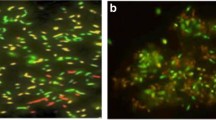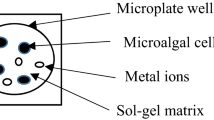Abstract
This work describes the design of a conductometric biosensor intended to monitor aquatic environments. The biosensor is based on the measurement of Alkaline Phosphatase Activity (APA) of the microalgae Chlorella vulgaris. This activity is inhibited in the presence of heavy metals. The purpose of this article is to obtain a tool for detection of heavy metals through inhibition of APA. The biosensor is composed of two parts: two platinum interdigitated electrodes which form the transducer, and the microalgae, the bioreceptor. The microalgae were immobilized on self-assembled monolayers (SAMs) of alkanethiolate. The change in the local conductivity of the electrodes following the addition of the substrate allowed us to measure alkaline phosphatase activity of Chlorella vulgaris. Good repeatability (RSD < 5%) and reproducibility between different biosensors (RSD < 10%) were obtained. Lifetime is estimated to be 17 days. The originality of this work consists in the immobilization of algal cells on self-assembled monolayers. The advantage of the SAMs is that they do not form a physical barrier between the algae and the constituents of the reaction medium (whether the reaction substrate, or the toxic components are to be detected). In addition, these sensors permit to obtain good measurement repeatability. Detection limit of cadmium reaches ppb levels.







Similar content being viewed by others
References
Durrieu C, Tran-Minh C (2002) Optical algal biosensor using alkaline phosphatase for determination of heavy metals. Ecotoxicol Environ Saf 51(3):206–209
Pandard P, Vasseur P, Rawson DM (1993) Comparison of two types of sensors using eukaryotic algae to monitor pollution of aquatic systems. Water Res 27(3):427–431
Chouteau C et al (2004) Development of novel conductometric biosensors based on immobilised whole cell Chlorella vulgaris microalgae. Biosens Bioelectron 19(9):1089–1096
Ionescu RE, Abu-Rabeah K, Cosnier S, Durrieu C, Chovelon JM, Marks RS (2006) Amperometric algal Chlorella vulgaris cell biosensors based on alginate and polypyrrole-alginate gels. Electroanalysis 18(11):1041–1046
Vedrine C et al (2003) Optical whole-cell biosensor using Chlorella vulgaris designed for monitoring herbicides. Biosens Bioelectron 18(4):457–463
Dzyadevych SV et al (2005) Early-warning electrochemical biosensor system for environmental monitoring based on enzyme inhibition. Sens Actuators B Chem 105(1):81–87, Piet Bergveld Special Issue
Marrakchi M et al (2005) A novel proteinase K biosensor based on interdigitated conductometric electrodes for proteins determination in rivers and sewers water. Sens Actuators B Chem 111–112:390–395, Eurosensors XVIII 2004—The 18th European Conference on Solid-State Transducers
Chouteau C et al (2005) A bi-enzymatic whole cell conductometric biosensor for heavy metal ions and pesticides detection in water samples. Biosens Bioelectron 21(2):273–281
Durrieu C et al (2007) Wole cell algal biosensor for urbain waters monotoring. in NOVATEC. Lyon
Albareda-Sirvent M, Merkoci A, Alegret S (2000) Configurations used in the design of screen-printed enzymatic biosensors. a review. Sens Actuators B Chem 69(1–2):153–163
Peter J et al ( 1996) Detection of chlorinated and brominated hydrocarbons by an ion sensitive whole cell biosensor. Biosens Bioelectron 11(12):1215–1219
Cosnier S, Gondran C, Senillou A (1999) Functionalized polypyrroles: a sophisticated glue for the immobilization and electrical wiring of enzymes. Synth Met 102(1–3):1366–1369
Aksu Z, Egretli G, Kutsal T (1998) A comparative study of copper(II) biosorption on Ca-alginate, agarose and immobilized C. vulgaris in a packed-bed column. Process Biochem 33(4):393–400
Calik G et al (1999) Growth and [kappa]-carrageenan immobilization of Pseudomonas dacunhae cells for -alanine production. Enzyme Microb Technol 24(1–2):67–74
Kumar P, Satyanarayana T (2007) Optimization of culture variables for improving glucoamylase production by alginate-entrapped Thermomucor indicae-seudaticae using statistical methods. Bioresour Technol 98(6):1252–1259
Nguyen-Ngoc H, Tran-Minh C (2006) Sol–gel process for vegetal cell encapsulation. Mater Sci Eng C 27(4):607–611
Dzyadevych SV et al (2002) Development of enzyme biosensor based on pH-sensitive field-effect transistors for detection of phenolic compounds. Bioelectrochem 55(1–2):79–81
Chen H et al (2005) Detection of Saccharomyces cerevisiae immobilized on self-assembled monolayer (SAM) of alkanethiolate using electrochemical impedance spectroscopy. Anal Chim Acta 554(1–2):52–59
Gau J-J et al (2001) A MEMS based amperometric detector for E. coli bacteria using self-assembled monolayers. Biosens Bioelectron 16(9–12):745–755
Hleli S et al (2006) Atrazine analysis using an impedimetric immunosensor based on mixed biotinylated self-assembled monolayer. Sens Actuators B Chem 113(2):711–717, special issue—in honour of Professor Karl Cammann
Zhao Y-D et al (1999) DNA-modified electrodes; part 4: optimization of covalent immobilization of DNA on self-assembled monolayers. Talanta 49(4):751–756
Fitzgerald GP, Nelson TC (1966) Extractive and enzymatic analyses for limiting or surplus phosphorous in algae. Phycology 2:32–37
Wang X et al (2006) Development of a conductometric nitrate biosensor based on methyl viologen/Nafion(R) composite film. Electrochem Commun 8(2):201–205
Choi SH, Lee JW, Sim SJ (2005) Enhanced performance of a surface plasmon resonance immunosensor for detecting Ab-GAD antibody based on the modified self-assembled monolayers. Biosens Bioelectron 21(2):378–383
Bucher J-P, Santesson L, Kern K (1994) Thermal healing of self-assembled organic monolayers: hexane- and octadecanethiol on Au(111) and Ag(111). Langmuir 10(4):979–983
Guo L-H et al (1994) Effect of gold topography and surface pretreatment on the self-assembly of alkanethiol monolayers. Langmuir 10(12):4588–4593
Author information
Authors and Affiliations
Corresponding author
Rights and permissions
About this article
Cite this article
Guedri, H., Durrieu, C. A self-assembled monolayers based conductometric algal whole cell biosensor for water monitoring. Microchim Acta 163, 179–184 (2008). https://doi.org/10.1007/s00604-008-0017-2
Received:
Accepted:
Published:
Issue Date:
DOI: https://doi.org/10.1007/s00604-008-0017-2




